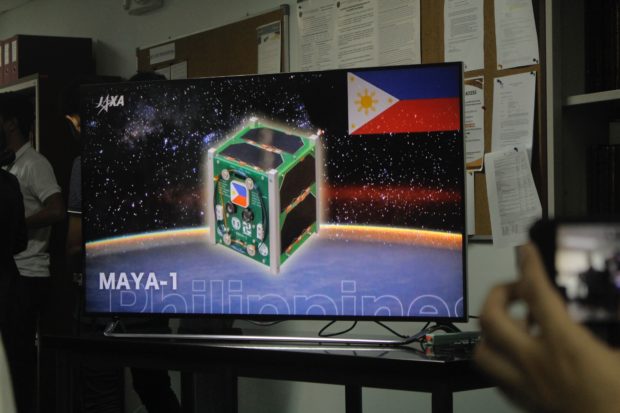Prof, engineers assure Maya-1’s radio function won’t be abused despite possibility

INQUIRER.net photo / Gabriel Pabico Lalu,
Professors and engineers involved with the recent development of Maya-1, the Philippines’ first cube satellite (CubeSat), dismissed concerns that amateur radio enthusiasts would abuse or prank the system.
University of the Philippines (UP) Electrical and Electronic Engineering (EEE) Professor Joel Joseph Marciano Jr. and engineers Izrael Bautista and Lorenzo Sabug Jr. said in an interview after Maya-1’s deployment on Friday that amateur (HAM) radio enthusiasts can actually contact the CubeSat.
“Mayroon tayong ground station dito (at UP-EEE), sa fifth floor […] ire-receive namin ‘yong beacon na tinatawag, ‘yong message from the satellite na nagsasabi na nandito siya,” Bautista told reporters who watched Maya-1’s live launching.
(We have a ground station here at UP-EEE, at the fifth floor… we will receive the beacon, the message from the satellite that says it is here.)
“So ‘yong information na ‘yon, kami rin ang magko-control kung kailan siya magse-send ng data, kung magre-receive,” he said.
Article continues after this advertisement(So, that piece of information, we will also be the one to control when it will send the data, when it will be received.)
Article continues after this advertisementTo explain the matter to people who are not well-versed with satellite engineering, Marciano agreed that the satellite, in a way, functions like a wireless printer.
“In a way parang si (wireless) printer may memory siya ‘di ba? Kung ano ‘yong pinadala mo sa kanyang data iso-store niya ‘yon tapos ipa-process niya, kung ano man ang gagawin niyo, gagawin niya,” the professor explained.
(In a way it is like a wireless printer that has a memory. If what data was sent, that is the data that will be stored by the satellite then it will processe, whatever it is tasked to do, it will do.)
“Ito ang gagawin niya, imbis na ipi-print out niya, hinihintay niya kasi gumagalaw siya ‘di ba, pagdating niya sa isang part ng Pilipinas, doon niya ipi-printout o ita-transmit,” he noted.
(This is what it is tasked to do, instead of printing out, it will wait because it is moving, when it reaches a certain part in the Philippines, there it will print out or transmit.)
They also clarified that the users in the Philippines are well disciplined, as they belong to a community who understands the importance of these services.
‘Yong mga HAM radio (enthusiasts), it’s a community. By definition in a community, we follow certain rules, maybe not necessarily written, but they police each other,” Marciano claimed.
“If somebody is abusing it, it’s easy to call them out,” he added.
Sabug, himself a HAM radio users, also relayed that aspiring enthusiasts would have to go through certain tests from the National Telecommunications Commission (NTC) before being allowed to operate.
“‘Yong mga tao po na gumagamit ng amateur radio, mga licensed po ito. [Those who are using these amateur radio, they are licensed.] Actually everyone can be an amateur radio operator, you just have to take an exam in NTC,” Sabug said.
“‘Yong exam na ito tine-take natin para malaman natin saka ma-inform ‘yong mga tao na nagte-take nito kung ano ‘yong mga responsibilities ng mga amateur radio operators,” he added.
(These exams we are taking, it is for us to know and to inform the people taking these exams what are the responsibilities attached to amateur radio operators.) /jpv
RELATED STORY